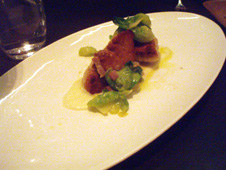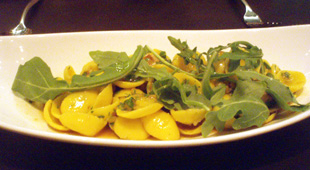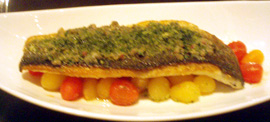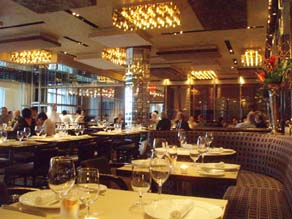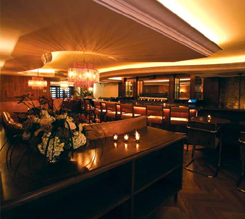A Voce Columbus
 Wednesday, September 14, 2011 at 02:57PM
Wednesday, September 14, 2011 at 02:57PM 
Note: A Voce Columbus closed in August 2016, after a judge approved its petition for bankruptcy. Eater.com has a lengthy backgrounder, which states that the restaurant was $4 million in debt, and had been losing money since 2011. The review below was written when Missy Robbins was the chef; she left the restaurant in May 2013. The sister restaurant, A Voce Madison, remains open; one has to wonder how long that’ll last.
*
If you want to know what luxury dining in the city has come to, wrapped in one package, you might as well have a look at A Voce Columbus. The restaurant is clearly intended to appeal to high rollers, with its entrées mostly in the $30s and wine bottles that go as high as five figures. It was intended to earn a Michelin star (which it did) and three Times stars (which it did not).
But it remains punishingly loud, as it was when I visited two years ago. Its predecessor in the space, the failed Café Gray, shared the same drawback, and then some. As of today, the only improvement in the ambiance is that there are frequently empty tables, and hence, fewer human beings contributing to the cocophany.
 Not that A Voce Columbus will be going out of business, but prime-time tables are now available at short notice, any night of the week. Thirty minutes in advance of my 7:30 p.m. reservation on a Wednesday, the staff seated me without a moment’s hesitation, once I spied that there were no vacant perches at the bar. By the time we left, the dining room was about two-thirds full.
Not that A Voce Columbus will be going out of business, but prime-time tables are now available at short notice, any night of the week. Thirty minutes in advance of my 7:30 p.m. reservation on a Wednesday, the staff seated me without a moment’s hesitation, once I spied that there were no vacant perches at the bar. By the time we left, the dining room was about two-thirds full.
The menu is expensive if you order the traditional four courses; on the other hand, if you order a pasta as your entrée (as my girlfriend did) and skip dessert (as we both did), A Voce becomes a pretty good mid-priced Italian restaurant.
The house-made bread with riccota cheese and olive oil (above right) remains a highlight, as it was two years ago.


The food is improved over my last visit. The menu emphasizes uncomplicated pleasures, but chef Missy Robbins does a good job in the niche she chooses to occupy. A perfect example is the Escarole Salad ($10; above left) with warm pancetta vinaigrette, a soft boiled egg, and pecorino romano.
I somewhat struggled with the point of Cassoncini ($11; above right), with a pile of prosciutto di parma, alongside a bowl of soft, swiss chard and crescenza cheese-filled pockets of warm dough—both wonderful on their own, but lacking any relationship that I could discern. My ignorance, perhaps.


Brodetto ($22; above left) with mussels was an excellent example of the chef’s skill with pasta. Lamb Chops ($38; above right) had a thick char and rich flavor, but discs of lamb sausage were too salty. If you check in on foursquare, they comp a side dish. We tried the broccoli rabe (below), normally $8, but it was also too salty.


The wine list is a 68-page marvel that can appeal to bargain-hunters and the super-rich alike, with bottles ranging from $25 to $18,000 (1900 Château d’Yquem; hurry up, only one left). There are pages upon pages of expensive Barolo and Brunello verticals, but the website says that over half of the 2,700 bottles are under $90. Indeed, there is plenty below $50, including the 2004 Alturio ($46; above right), one of the more enjoyable bottles we’ve had in a while at that price range.
 For a restaurant this expensive, you’d like to see an amuse bouche and better petits fours than just a couple of sticky marshmallows (right)
For a restaurant this expensive, you’d like to see an amuse bouche and better petits fours than just a couple of sticky marshmallows (right)
Service was reasonably attentive. This isn’t the sort of restaurant where you just twitch an eyebrow to get a server’s attention, but they stay on top of things, and the sommelier circled back several times to ensure we were taken care of.
I remember when people joked about putting high-end restaurants in a shopping mall, but the location is ideal, served by subway lines on three avenues, convenient to Lincoln Center and the midtown business district.
I wish the space wasn’t so unpleasant, but if one wants to dine out, this is increasingly what we must accept nowadays.
A Voce Columbus (10 Columbus Circle, Time-Warner Center, 3rd floor)
Food: **
Service: **
Ambiance: *
Overall: **




